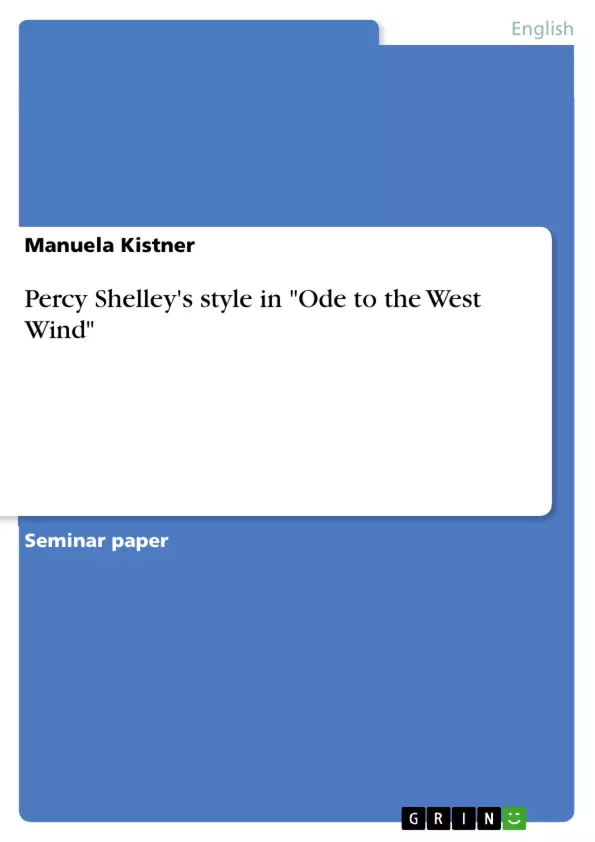Percy Bysshe Shelley is one of the most famous Romantic poets of the 19th century. Throughout his life he has written a lot of works that impressed people. One of these works is the poem ‘Ode to the West Wind’ which was written in 1819.
This paper is about ‘Ode to the West Wind’ and gives information on it, such as its outer appearance. It focuses on how Shelley describes the ‘wind’ and which symbols he uses in this poem.
First some information about the term ‘ode’ itself. The ode is a lyric poem with great length that deals with a “lofty theme in a dignified manner ”. There are three types of English odes: the Pindaric, the Cowley and the Horation ode. The Pindaric Ode is a ceremonious poem with Pindar’s style. Pindar was “a Greek professional lyrist of the 5th century BC. He employed the triadic structure of Stesichorus, [...] consisting of a strophe [...] followed by a metrically harmonious antistrophe, concluding with a summary line in a different metre. ” The most important odes were those of Abraham Cowley and Andrew Marvell. Marvell, for example, used “a simple and regular stanza [...] modelled on Horace” with the rhyme scheme aabb; the first two lines had four stresses, whereas the last two lines had only three stresses. Cowley wrote Pindaric odes “which had irregular patterns of line lengths and rhyme schemes, though they were iambic.”
Shelley’s Ode is of the Horation type; in it he describes the activities of the west wind on earth, on the sea and also in the sky. He also expresses “his envy for the boundless freedom of the west wind, and his wish to be free like the wind and to scatter his words among mankind”.
Table of Contents
- I. Introduction
- II. Main part
- a.) first stanza
- b.) second stanza
- c.) third stanza
- d.) fourth stanza
- e.) fifth stanza
- III. Conclusion
- IV. Bibliography
- V. Appendix I
- VI. Appendix II
Objectives and Key Themes
This paper examines Percy Bysshe Shelley’s 1819 poem, 'Ode to the West Wind', focusing on the poem’s outer appearance and Shelley’s descriptions of the wind and the symbols he utilizes. The paper explores the nature of the ode and its various forms. It then delves into the structure and imagery of the poem, examining the interplay between the wind’s destructive and generative forces.
- The nature of the ode and its forms
- The poet’s descriptions of the wind and the symbols he employs
- The structural and metaphorical features of the poem
- The interplay between destructive and generative forces in the poem
- The relationship between the poet and the wind
Chapter Summaries
The introduction provides background information on the poem and the poet, defining the ode and outlining the paper’s focus. It discusses the various types of odes, including the Pindaric, Cowley, and Horation forms.
The main part of the paper examines the five stanzas of the poem, exploring their structure, rhyme scheme, and imagery. The first stanza, with its focus on the destructive power of the wind, highlights the poem's complex themes of death and regeneration. The analysis of the poem's imagery, such as the dead leaves, the 'azure sister of the Spring,' and the 'corpse within its grave,' reveals the poet's portrayal of the wind as both destroyer and preserver.
Keywords
The key terms and topics of this paper include: Percy Bysshe Shelley, 'Ode to the West Wind', ode, terza rima, wind, death, regeneration, imagery, symbolism, destructive power, generative force, nature, poet, language.
- Quote paper
- Manuela Kistner (Author), 2005, Percy Shelley's style in "Ode to the West Wind", Munich, GRIN Verlag, https://www.grin.com/document/49133



